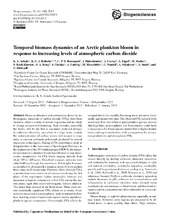| dc.contributor.author | Schulz, Kai G. | |
| dc.contributor.author | Bellerby, Richard | |
| dc.contributor.author | Brussaard, Corina P.D. | |
| dc.contributor.author | Büdenbender, Jan | |
| dc.contributor.author | Czerny, Jan | |
| dc.contributor.author | Engel, Anja | |
| dc.contributor.author | Fischer, Matthias | |
| dc.contributor.author | Koch-Klavsen, Signe | |
| dc.contributor.author | Krug, Sebastian A. | |
| dc.contributor.author | Lischka, Silke | |
| dc.contributor.author | Ludwig, Andrea | |
| dc.contributor.author | Meyerhöfer, Michael | |
| dc.contributor.author | Nondal, Gisle | |
| dc.contributor.author | Silyakova, Anna | |
| dc.contributor.author | Stuhr, Annegret | |
| dc.contributor.author | Riebesell, Ulf | |
| dc.date.accessioned | 2019-02-26T17:19:37Z | |
| dc.date.available | 2019-02-26T17:19:37Z | |
| dc.date.issued | 2013-01-11 | |
| dc.Published | Schulz KG, Bellerby R, Brussaard CP, Büdenbender, Czerny J, Engel A, Fischer M, Koch-Klavsen, Krug, Lischka, Ludwig, Meyerhöfer M, Nondal G, Silyakova A, Stuhr, Riebesell U. Temporal biomass dynamics of an Arctic plankton bloom in response to increasing levels of atmospheric carbon dioxide. Biogeosciences. 2013;10:161-180 | eng |
| dc.identifier.issn | 1726-4170 | en_US |
| dc.identifier.issn | 1726-4189 | en_US |
| dc.identifier.uri | https://hdl.handle.net/1956/19153 | |
| dc.description.abstract | Ocean acidification and carbonation, driven by anthropogenic emissions of carbon dioxide (CO2), have been shown to affect a variety of marine organisms and are likely to change ecosystem functioning. High latitudes, especially the Arctic, will be the first to encounter profound changes in carbonate chemistry speciation at a large scale, namely the under-saturation of surface waters with respect to aragonite, a calcium carbonate polymorph produced by several organisms in this region. During a CO2 perturbation study in Kongsfjorden on the west coast of Spitsbergen (Norway), in the framework of the EU-funded project EPOCA, the temporal dynamics of a plankton bloom was followed in nine mesocosms, manipulated for CO2 levels ranging initially from about 185 to 1420 μatm. Dissolved inorganic nutrients were added halfway through the experiment. Autotrophic biomass, as identified by chlorophyll a standing stocks (Chl a), peaked three times in all mesocosms. However, while absolute Chl a concentrations were similar in all mesocosms during the first phase of the experiment, higher autotrophic biomass was measured as high in comparison to low CO2 during the second phase, right after dissolved inorganic nutrient addition. This trend then reversed in the third phase. There were several statistically significant CO2 effects on a variety of parameters measured in certain phases, such as nutrient utilization, standing stocks of particulate organic matter, and phytoplankton species composition. Interestingly, CO2 effects developed slowly but steadily, becoming more and more statistically significant with time. The observed CO2-related shifts in nutrient flow into different phytoplankton groups (mainly dinoflagellates, prasinophytes and haptophytes) could have consequences for future organic matter flow to higher trophic levels and export production, with consequences for ecosystem productivity and atmospheric CO2. | en_US |
| dc.language.iso | eng | eng |
| dc.publisher | European Geosciences Union | en_US |
| dc.rights | Attribution CC BY | eng |
| dc.rights.uri | http://creativecommons.org/licenses/by/3.0 | eng |
| dc.title | Temporal biomass dynamics of an Arctic plankton bloom in response to increasing levels of atmospheric carbon dioxide | en_US |
| dc.type | Peer reviewed | |
| dc.type | Journal article | |
| dc.date.updated | 2018-07-02T12:19:24Z | |
| dc.description.version | publishedVersion | en_US |
| dc.rights.holder | Copyright 2013 The Authors | en_US |
| dc.identifier.doi | https://doi.org/10.5194/bg-10-161-2013 | |
| dc.identifier.cristin | 1032125 | |
| dc.source.journal | Biogeosciences | |
| dc.subject.nsi | VDP::Matematikk og naturvitenskap: 400::Zoologiske og botaniske fag: 480::Økologi: 488 | |
| dc.subject.nsi | VDP::Mathematics and natural scienses: 400::Zoology and botany: 480::Ecology: 488 | |

